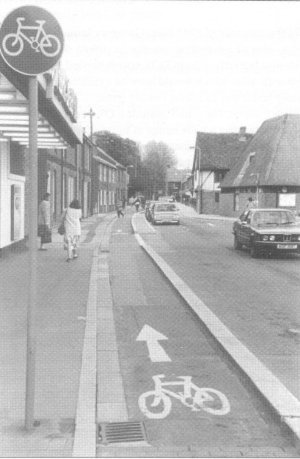Bicycles and Bicycling - TrustNews Summer 1996

Cycle lane across a bridge in North Walls Recreation Ground,
cyclists share the path with pedestrians except over the bridge
With cycling in the public eye following the recent National Bike Week and Car Free Day, it seems appropriate for me as the Trust's representative, to report on the Cycling Working Group. This Working Group, set up by the City Council, includes representatives of the City and County (officers and councillors), the Police, and of colleges of higher education, cycling and other organisations in Winchester, and is looking to develop a cycling strategy for Winchester into the millennium.
Many of the streets of Winchester are not conducive to cycling; they are narrow and busy. The City has, however, put in place a North to South cycle route between Worthy Road and St Cross. The route largely follows quieter streets, and the cyclist still has to compete with the car, except where a short stretch of segregated path for cyclists has been marked out at the St Thomas/St Swithun Street junction and for the contraflow lane in Middle Brook Street; the cycle phase of the traffic lights at the North Walls junction with Middle Brook Street for cyclists going North is the most recent improvement. In the North Walls Recreation Ground, cyclists share the path with pedestrians, except for the segregated cycle lane across a bridge (see photograph below).

The contraflow lane in Middle Brook Street
Future plans include the extension of this cycle route North to Kingsworthy and South to Five Bridges Road, with the possibility of shared use of the pavement beside the main road. This is a contentious issue, but where a pavement is reasonably wide and the pedestrian use low, it is perhaps the best option available. When road improvements or new roads are planned, the aim is to ensure that the needs of cyclists are taken into account at the design stage.
Cyclists with expensive machines need to be able to park their cycles safely. Recently about 100 hoops (Sheffield stand) and Cyclevices have been installed in the City Centre. Hoops have been used in the more sensitive areas such as the High Street and the Broadway. Cyclevices have been placed in less visible areas; cyclevices enable the frame and both wheels to be secured by steel bolts. The Trust's views on proposed locations has had some effect, for example, the planned location of cyclevices in the North Walls Recreation Ground near the Park Avenue entrance, obscuring the river view, was changed to the Trust's preferred site to the left of the path.
Small measures can aid cyclists, like the dropping of a kerb or the alignment of a drainage grid across the road. If members have practical suggestions for improving conditions for cyclists within the City, Rosemary Ralph of the Engineering Department of Winchester City Council (848302) would welcome them.
